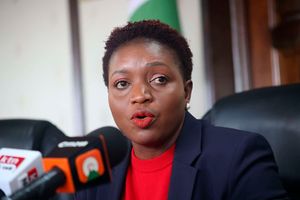Happening Now: Senators grill CS Nakhumicha amid doctors' strike
Let’s show Para-athletes that we appreciate them

Samuel Muchai (centre), who is visually impaired, is among those who did well in the Rio Paralympics. The Kenya Paralympic team missed the first qualifying rounds in Doha in October last year. PHOTO| JARED NYATA
What you need to know:
- The timing of the event — two weeks after the Olympics — is also telling. By that time most people have got over the excitement of the Olympics and are not really interested in another sporting festival.
- Also worth noting is that the Paralympics budget is almost always inadequate A week before the games, there was a real possibility of either reduced teams or no competition at all.
- In fact, the International Olympic Committee Chairman, Mr Thomas Bach, did not attend the Paralympics opening ceremony; he was quoted in the British media as saying that he was attending the funeral of former West Germany president Walter Scheel.
At exactly 8pm on Friday last week, the Kenyan Paralympics team touched down at the Jomo Kenyatta International Airport from Rio to a low-key reception – no flashing camera lights, no traditional dancers, none of the usual fanfare that greets the return of the Olympics athletes.
Yet they had brought back three gold, one silver and two bronze medals, and had finished 35th overall and sixth in Africa to better Kenya’s performance in London in 2012, when the country finished 40th overall.
Equally remarkable was that there was very little media coverage of the games, with just the occasional update, unlike in the case of the Olympic Games, where updates are given almost by the hour.
Indeed, while every local media house sent at least one journalist to cover the Rio Olympics, not a single one sent any journalist for the Paralympics.
TIMING TELLING
The timing of the event — two weeks after the Olympics — is also telling. By that time most people have got over the excitement of the Olympics and are not really interested in another sporting festival.
Also worth noting is that the Paralympics budget is almost always inadequate A week before the games, there was a real possibility of either reduced teams or no competition at all. In fact, the International Olympic Committee Chairman, Mr Thomas Bach, did not attend the Paralympics opening ceremony; he was quoted in the British media as saying that he was attending the funeral of former West Germany president Walter Scheel.
But despite this lack of interest by the media, the public and the duplicity of local sports authorities, the Kenyan athletes represented the country well, and without the horrors of the disorganisation and embarrassment that marked the Olympics athletes’ campaign.
Samuel Muchai won double gold in the 1,500m T11 and 5,000m T11 races, while Henry Kirwa, a triple gold medallist in Beijing, China, in 2012, also engraved his name in the books with a gold in the 5,000m T13. Nancy Chelagat proved her mettle to clinch silver in the 1,500m T11, while Wilson Bii (5,000m T11) and Henry Kirwa (1,500 T13) bagged bronze medals.
The Paralympic Games are a major international multi-sport event that bring together talented athletes with varying disabilities.
All Paralympic Games are governed by the International Paralympic Committee (IPC), although there are also the Special Olympics and the Deaflympics, which are recognised by the Olympics Committee as legitimate events dedicated to athletes with different disabilities.
At a glance, the event seems to be growing in terms of the number of athletes who participate (from 3,053 in 1988 to 4,200 in 2012), participating countries (from 62 to 161) and accredited media houses that cover the event (from 1,672 to around 4,000).
Spectators are more familiar with wheelchair games such as rugby, basketball and tennis since it appears that the athletes compete on an equal footing. But the truth is that the players in each game have varying ranges of functional ability.
CLASSIFICATION ISSUES
The classification of athletes in the Paralympics games is a complex affair and has drawn sharp criticism from various quarters, including the athletes themselves, disability groups, some athletics federations and the media, and remains one of the greatest challenges to the organisers.
Fundamental facilities like the track, which is the same for men and women in the Olympics, are completely different for the Paralympics. For instance, there can be up to 20 tracks for each gender in the Paralympics 100m, depending on the level of the athletes’ disabilities.
Thus the challenge for the organisers has been to give more concise explanations for the different classifications.
Now, five medals from such an event might not look like a brilliant return, but to really understand the athletes’ success, one needs to take a closer look at the games.
Just like the Olympic Games, the Paralympics Games highly favour the West, what with the inclusion of sports like wheelchair fencing, sailing and equestrian events, which are not found in many parts of the developing world. So it is not surprising that the big medal-winners usually come from the US, Australia, Great Britain and Germany.
The Paralympics are not as popular as the Olympics, viewership is not high, the games are not as widely watched, and the champions can in no way be compared with the best from the Olympics.
So what exactly motivates Paralympians?
OVERCOMING CHALLENGES
“To suggest that the Paralympics are less important than the Olympics, as happens every so often, is the same as saying that women’s sport is less important than men’s,” says Agnes Oluoch, who chairs the Kenya National Paralympics Committee (KNPC). “The fact that we are living with a disability should be reason enough to champion such competitions.”
Indeed, the Paralympics are about sportsmen and women overcoming challenges such as discrimination, exploitation by agents and rogue federations and lack of funding just to compete on the biggest stage.
Paralympic sports challenge convention, and it is not until one gets closely involved with this calibre of athletes that one really gets to understand them.
For instance, the fact that Paralympic athletes struggle to do some of the things that able- bodied people consider “normal” does not diminish them as sports people.
So it was disturbing to see the our local athletes training barefoot while their colleagues who were eyeing the Olympics were being hounded by the local and international media at their training bases in Eldoret and Nairobi.
For years the national Paralympics team has been dogged by financial challenges, and they missed this year’s first round qualifiers in Doha in October last year due to lack of funds. By the time the government eventually gave them money, the qualifiers had entered the third round.
QUALIFYING ROUNDS
Still, they managed to enter the subsequent qualifying rounds in Morocco, Dubai and Tunisia early this year, and most of the athletes who qualified for Rio did so at the IPC athletics competition in Marrakech, Morocco.
But watching them cruise to a podium finish, you realise that para-athletes, too, understand the sporting journey.
They appreciate the long, hard road they have to take to get to major athletics competition and just like their able-bodied counterparts, they acknowledge the challenges faced in their day-to-day regimens.
They take their events seriously and have the same desire, commitment and attention to detail and make sacrifices in order to succeed. In fact, they even laugh at those who are uncomfortable discussing disability.
All these athletes ask for is that people engage with them.
Listening to them, one gets the feeling that they want to be interviewed simply as sports people. They want people to talk about their achievements in athletics rather than focus on a side story that reminds audiences only of their shortcomings, of their imperfect physiology.
Having lived with disabilities all their lives, they are not looking for sympathy. There is too much at stake, too much to be getting on with to spend time worrying how others perceive them.
“Journalists do not ask the intimate questions about our journeys. It is like they don’t want to get too involved. They are afraid it might offend us,” Muchai says with a light chuckle, obviously unaware that the media avoid those questions because they — and the public— have only a vague idea of the meaning and purpose of the Paralympics.
Prior to their departure, the national team had complained of neglect and pleaded with well-wishers to come to their aid.
CORPORATES GROSSLY UNFAIR
“These athletes feel that it is grossly unfair for corporates to focus on the able-bodied team while completely ignoring the Paralympians, yet they are all going to participate in a similar event,” Ms Oluoch had said at that time.
But that is not to say that para-athletes want to be viewed as a sporting experts.
Still, American journalists have coined the word “supercrip” (super cripple), a word meant to stroke the para-athletes’ ego. But para-athletes know that their disabilities do not give them superhuman powers. They are not asking for media advocacy that paints them asbeing on a mission to paralympify the planet.
The Paralympics are designed to address a lack of understanding in society.
“Imagine the confidence boost a child with a disability gets and the impact it has on his life when he see someone like him competing and coming out as a great athlete,” team manager John Tita offers.
So what are the Paralympics about?
The Paralympics are about acknowledging the talents and strengths of people with physical or mental impairments. The games should be a lesson in overcoming challenges, never losing self-belief, inclusion, social awareness and improving self-confidence.
Ultimately, they should be a celebration of how sports can be used to change mindsets and attitudes and to create opportunities for the less fortunate in society.
Which is why it was unfortunate that it was not until the very last stages of the para-athletes’ preparations that the government stepped in and offered to cover their remaining costs.
Muchai and his team-mates achieved commendable success in this year’s games and with more support could do even better in future. And this support should be not just in terms of access to sports facilities and clubs, but also to expert coaching and knowing the emotional and psychological needs of the athletes.
The media should strive to give the games greater coverage, as opposed to reinforcing the stereotype that nobody is interested in the Paralympics.
Corporates could also help create awareness of these athletes, by sponsoring them and encouraging people to attend events such as sitting volleyball because full arenas not only benefit the organisers and sponsors, but also make the Paralympians feel fully appreciated as opposed to being made to feel less important. It is the only way to reach out to them and make the games as important as the Olympics.
CORRECTION
In our story on Monday about sculptor Edward Njenga, we said that one of his artworks was sold for Sh2.4 million, and that he received Sh1.5 million. We have since learnt from Circle Art Gallery that Njenga received Sh1.6 million while the gallery received only a 20 per cent commission on the sale, whose sum was not disclosed. We sincerely regret any embarrassment caused to the gallery.





